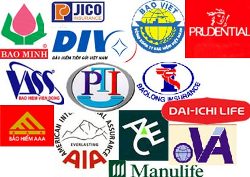VN’s urban and rural areas offer high potential, Manulife says
VGP - Both urban and rural areas of Việt Nam offer growth prospects, as the country's insurance sector enters its second decade of development, according to Manulife Việt Nam Ltd.
 |
|
The logos of some international and domestic insurers in Việt Nam |
This segment remains the "core competency" of the insurer's life business, said David Wong, chief executive of Manulife Việt Nam. But the countryside is ripe with opportunities.
About three-quarters of the Vietnamese population live in rural areas, while agriculture accounts for 22% of the country's gross domestic product and 55.6% of the total labor force. "The rural population is going to be a huge market segment in Việt Nam," said Wong.
"Micro-insurance is not micro [in this part of the region]," said Wong in an interview. A rethinking of insurance strategy is necessary for such an emerging market that has its own distinctive social structure and development like Việt Nam.
In Việt Nam, micro-insurance products have a premium rate of about US $20 per year, and claim capacity is about US $1,000.
Last September, Manulife Việt Nam initiated a micro-insurance project in Hải Phòng and Tiền Giang, in cooperation with a nonprofit organization, Việt Nam Women's Union. The rural project acquired new policies from nearly 16,000 women union members.
Manulife Việt Nam is looking to build up this rural customer base to 500,000 to 600,000 policyholders in the future, said Wong. It is anticipated that 10% of these policyholders may emerge as a higher income.
group, who could then purchase a regular insurance policy.
In promoting micro-insurance, Wong said partnerships with non-profit or social institutions are essential to reach villages with adequate administrative support. Training is given to the administrative staff of the nonprofit organization.
Market Evolution
Việt Nam has a promising life insurance market as its young demographic structure offers attractive growth potential, according to Wong. The emergence of a middle class has created prefect timing for life insurance business.
With a population of about 88 million, Việt Nam's median age stands at 27.4 years.
In 2008, Việt Nam's insurance industry generated VND 21.3 trillion in premiums, up 20.4% from the previous year's VND 17.7 trillion. With one local and 10 foreign insurers, the life sector saw a 9.2% rise in premiums to VND 10.3 trillion, according to Swiss Re's world insurance sigma report.
Việt Nam’s three largest life insurers in 2008 were U.K-based Prudential plc with VND 4.27 trillion in premiums; domestic insurer Bảo Việt with VND 3.4 trillion; and Manulife with VND 1.07 trillion, according to the Ministry of Finance. The life insurance sector is expected to see annual growth of 8% to 10% through 2010.
The country's life and non-life insurance penetration stood at 0.7% and 0.74%, respectively, in 2008, according to Swiss Re's sigma report. Similar to other emerging markets, Việt Nam is working to develop infrastructure, legal and regulatory frameworks.
Việt Nam now has 11 life insurers, 27 non-life insurers, one re-insurer and 10 brokers. A foreign insurer is allowed to have a wholly owned company without restrictions on branch operations.
Insurance distribution is dominated by agents, while bancassurance is just taking off as an alternative channel. As less than 10% of the population has a bank account, bancassurance has not yet been developed in Việt Nam.
(Source: TradingMarkets.com)

